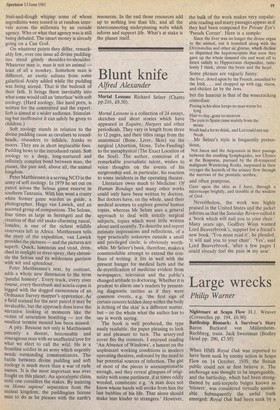Large wrecks
Philip Warner
Nightmare at Scapa Flow H.J. Weaver (Cressrelles pp. 194, £6.90) . Battleship Bismark: A Survivor's Story Baron Burkard von MiillenheimRechberg, trans. Jack Sweetman (Bodley Head pp. 290, £7.95) When HMS Royal Oak was reported to have been sunk by enemy action in Scapa Flow on 14 October, 1939, the British public could not at first believe it. The anchorage was thought to be impregnable, and the battleship, which had been strengthened by anti-torpedo bulges known as 'blisters', was considered virtually unsinkable. Subsequently the awful truth emerged: Royal Oak had been sunk by a German submarine which had escaped undetected. 833 officers and men died and still lie in the battleship's hull; 424 escaped but many died serving on other ships and only 60 are alive today. Later in the war the public would be less surprised when unsink able ships were sunk and impregnable fortresses fell, but the Royal Oak disaster, occurring when landsmen were talking about 'a phoney war' in which Germany's bluff would soon be called, had a chilling impact.
Mr Weaver's book is subtitled 'the truth about the sinking of HMS Royal Oak and it certainly seems a very thorough and competent investigation. He provides a clear and interesting survey of previous accounts and theories, examines various possibilities, evaluates everything in the light of his own research, and quotes extensively from both British and German sources. The text is lively but less sensational than the title, the technical information is adequate, and there is occasional humour. However, the arrangement is often jerky and the book lacks an index.
Skill is shown in the separation of truth from fantasy in the story of Lt Prien, commander of U-47, the submarine from which the torpedoes were launched. Prien's much publicised book was ghosted and he did not survive its publication long enough to correct its exaggerations and errors. U-47, and all hands, was sunk by HMS Wolverine (a destroyer) on 8 March 1941. The account of that operation shows the Navy at its most relentless and skilful, thus countering the impression given by the Royal Oak disaster.
But U-47's log had been copied and is reproduced in this book. By 1941 some of the submarine's crew had been transferred' to other ships; one of them, the torpedomechanic, now lives in Scotland and works fo'r a British company. He was available for interview.
But the whole truth of that mysterious sinking is not easily found. Prien thought he had also torpedoed Repulse, which was not there at all. In fact, Royal Oak had had a 40 foot wide hole blown in her by one of the first three torpedoes. This was thought to have been a bomb 'but was not considered serious', and 'many of the crew, reassured, simply turned in again'. Twelve minutes later U-47 despatched three more torpe does. All three found their target and exploded. Thirteen minutes later Royal Oak had gone.
Unlike the veteran Royal Oak , which had fought at Jutland, the Bismark was on its first operation — `to do the greatest possible damage to the enemy by destroying his merchant shipping . . the work of destruction may not be delayed by rescue operations'. It was the biggest and best the German shipyards could produce and, as events proved, it was very good indeed.
Baron Burkard von MfillenheimRechberg who has subsequently held a number of important posts in the Federal German Diplomatic Service, was Adjutant to the Captain of the BLsmark and also fourth gunnery officer. His Captain, Ernst Lindemann, insisted that the Bismarck must always be referred to as 'he', not 'she' as was customary with other ships. By treaty limitations German battleships could not exceed 35,000 tons; but Lindemann confided with pride that Bismarck was 53,000 tons. This made her vastly superior to HMS Hood, a 48,000 ton battle-cruiser which had not been fully modernised since she had been built in 1920, with the result that Hood was sunk within half an hour of their first meeting.
However, as has been told dramatically on film and more soberly in books, Hood's avengers converged on the Bismarck, although bad weather nearly caused them to lose their prey. Finally, with the rudder damaged by aircraft, the German ship had its guns destroyed by King George V and Rodney, and was finished off by torpedoes from the cruiser Dorsetshire. Of the 2,200 on board, only 115 were saved.
Naturally enough the Baron was proud to have held a responsible post on a masterpiece of naval engineering and tells his story with scrupulous fairness and frankness. He appears to believe that better direction from the top might have saved his ship but he does not seek sympathy. He had observed that when Hood was sunk she managed to fire a last salvo when she had already broken in two, 'something I could hardly believe'. But he could take a justified pride in the way the Bismark fought to a finish when her turn came.
Both books contain clear illustrations and maps and both are extensively documented.







































 Previous page
Previous page